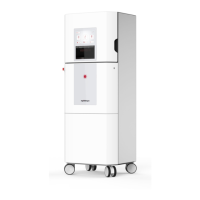Operating Instructions D50+ | P50+ | SHERAprint 50
Rapid Shape GmbH │ DOCR000438
1.6 Personnel Requirements
WA RNING!
Risk of injury in case of inadequate qualification of
personnel!
If unqualified personnel carry out work on the machine,
dangers arise which can cause injuries and material
damage.
– All activities must be carried out by qualified
personnel only.
The operator is the person who operates the machine for commercial
or economic purposes or loans it to a third party for operation and
bears legal product responsibility during the operation for the
protection of the user, the personnel or third parties.
The operator has been trained by the manufacturer in handling the
machine and the necessary accessories and can recognize possible
dangers independently and avoid hazards.
The operator is obliged to
– read these operating instructions fully before using the system for
the first time.
– to ensure that all persons working with the machine have read
and fully understood the contents of these operating instructions.
– provide these operating instructions for the personnel at a fixed
location near the machine.
– regularly inform all persons who work with the machine about
the current general accident protection guidelines. The operator
must ensure that precautionary safety measures at work are
respected.
– inspect first aid facilities and fire protection regularly and to keep
them up to date.
– provide the prescribed safety equipment to all persons working
with the machine.
– check all safety devices and safety equipment regularly for their
functionality.
Due to their professional training, knowledge, and experience as well
as knowledge of the relevant standards and regulations, electricians
are able to carry out work on electrical systems and to recognize and
avoid possible dangers independently. The qualified electrician has
been specially trained in the working environment in which he or she is
active.
Impaired Persons & Trainees
Only persons who can be expected to perform their work reliably are
eligible as qualified personnel. People whose response capacity has
been affected, e.g., through drugs, alcohol, or medication, may not
work on the machine.
Personnel who are being trained, instructed, taught, or undergoing
general apprenticeships should only be allowed to work on the
machine under the constant supervision of the operator.

